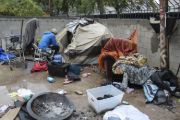- Harold Fjord
- Jan 3, 2004
-

|
It's Jovan's paradox all the way down. Anything we use more of is bad anything we use less of becomes cheaper and we don't use less after all.
|
 #
?
Dec 8, 2022 17:20
#
?
Dec 8, 2022 17:20
|
|
- Adbot
-
ADBOT LOVES YOU
|

|
|
#
?
Jun 7, 2024 15:12
|
|
- cat botherer
- Jan 6, 2022
-

I am interested in most phases of data processing.
|
It's Jovan's paradox all the way down. Anything we use more of is bad anything we use less of becomes cheaper and we don't use less after all.
|
 #
?
Dec 8, 2022 17:22
#
?
Dec 8, 2022 17:22
|
|
- A big flaming stink
- Apr 26, 2010
-
|
what the gently caress cinci, this is a legit good post
it's completely valid to point out that electrifying vehicles is a vastly inadequate response to climate change, especially cars that blatantly should not exist (SUVs)
|
 #
?
Dec 9, 2022 01:56
#
?
Dec 9, 2022 01:56
|
|
- Mischievous Mink
- May 29, 2012
-

|
what the gently caress cinci, this is a legit good post
it's completely valid to point out that electrifying vehicles is a vastly inadequate response to climate change, especially cars that blatantly should not exist (SUVs)
I'm really confused about the probation being for not reading the source cited, when I looked at the source and it seems to agree with cat botherer and the tweet they linked.
|
 #
?
Dec 9, 2022 02:22
#
?
Dec 9, 2022 02:22
|
|
- Discendo Vox
- Mar 21, 2013
-

This does not make sense when, again, aggregate indicia also indicate improvements. The belief that things are worse is false. It remains false.
|
Even without getting into its significant methodological defects, the article finds an increase in emissions in one most extreme model scenario and has an actual set of conclusions that are all about that the battery resource flow needs to be managed, and that reduced motorization should also be pursued. It is also not actually an argument against electrification of SUVs in itself, which is how it's being misrepresented.
|
 #
?
Dec 9, 2022 02:57
#
?
Dec 9, 2022 02:57
|
|
- BRJurgis
- Aug 15, 2007
-

Well I hear the thunder roll, I feel the cold winds blowing...
But you won't find me there, 'cause I won't go back again...
While you're on smoky roads, I'll be out in the sun...
Where the trees still grow, where they count by one...
|
Its low content and I take having to click a Twitter link a little personally, but "7 days for posting as cat botherer" should get some pushback.
General climate discussion out there is so brainlessly, profitably toxic positivity copium... always an upshot and a reason to have hope! Agitators are the heroes of climate change discussion, haven't climate scientists self immolated within the last year or two?
|
 #
?
Dec 9, 2022 03:02
#
?
Dec 9, 2022 03:02
|
|
- Owling Howl
- Jul 17, 2019
-
|
The European Union is working on a carbon tax tariff scheme. Financial Times did a piece on it.
EU’s trading partners accuse bloc of protectionism over carbon tax plan
Brussels negotiations continue as world-first levy faces criticism from US, China and African nations
The EU’s trading partners have hit out at the bloc’s plan to introduce the world’s first carbon border tax, saying it is protectionist and puts export industries at risk, as negotiations to complete the deal stretch into the weekend.
Several developing nations have already begun to negotiate with Brussels for waivers on the proposals, which are provisional until a final set of talks conclude this weekend. After that the agreement must be approved by EU ambassadors. Issues outstanding include the specific dates for its gradual phase-in.
German lawmaker Michael Bloss, a European parliament negotiator, said on Saturday that “a lot was negotiated” on Friday but “little was decided”. The talks “will continue and hopefully conclude the negotiations on Europe’s largest climate protection package”, he told Reuters.
Swedish lawmaker Emma Wiesner said Friday’s talks had achieved a “surprisingly big amount of progress”. Other EU officials told Reuters that deals had not yet been found on the most divisive issues.
The tax will require importers to buy certificates to cover their emissions based on calculations linked to the EU’s own carbon price. Iron, steel, cement, aluminium, fertilisers, hydrogen and electricity generation will all be covered by the deal. A trial period is set to start in October 2023.
If it is considered a success, the EU plans to expand the scheme to other sectors, including cars and organic chemicals.
A number of countries have approached the European Commission to request more flexibility in the tariff’s application, according to multiple people familiar with the discussions.
The plan has attracted criticism from countries including the US and South Africa, which said that the carbon border adjustment mechanism (CBAM) will unfairly penalise their manufacturers.
“We are particularly concerned about things like border adjustment taxes, and regulatory requirements that are imposed unilaterally,” Ebrahim Patel, South Africa’s trade minister, told the Financial Times. “If it gets to be an enormous defining thing between north and south, you’re going to have a lot of political resistance.”
“There are a lot of concerns coming from our side about how this is going to impact us and our trade relationship,” US trade representative Katherine Tai said at a conference in Washington this week.
The EU views the CBAM as a core part of its efforts to reach net zero emissions by 2050, arguing that it will simultaneously encourage countries outside the bloc to decarbonise their industrial sectors.
“CBAM is just a way to threaten third countries that they should also update their ambitions when it comes to climate,” said Mohammed Chahim, a Dutch socialist politician who has led negotiations on the law for the European parliament.
Before Russia’s invasion of Ukraine, it was set to be the country that was most affected by the CBAM. Russian exports made up the biggest proportion of imports from CBAM-affected sectors, according to an analysis by the Berlin-based think-tank Adelphi based on data for EU imports between 2015 and 2019.
The substantial fall in imports from Russia due to the EU’s sanctions regime and the destruction of Ukrainian industry has pushed the burden on to other countries.
China makes up around a tenth of affected imports, according to Adelphi, with Turkey and India also hit. China has frequently attacked the tariff since it was first proposed in July last year.
Developing nations with less economic heft and no systems in place for measuring emissions were more likely to suffer the most from the introduction of the levy, said Faten Aggad, senior adviser on climate diplomacy at the African Climate Foundation.
“The countries that are most likely to mitigate the risk of CBAM are the ones that already have proper carbon counting,” she said. The result could be a “deindustrialisation” in African nations that export to the EU.
“A lot of these sectors risk losing business unless we pump money into their sustainability and it’s very difficult to rebuild.”
Steelmakers in Brazil are concerned that the CBAM will put domestic producers at risk. Instead of shipping their goods to Europe, exporters might target less protected steel markets such as South America.
“Our big worry isn’t exports to [Europe],” said Marco Polo de Mello Lopes, executive president of the Instituto Aço Brasil, but rather that more material is diverted to the region, leaving domestic industry “vulnerable”.
Anger at the measure has been exacerbated by the EU’s insistence that the CBAM will encourage others to decarbonise, while not providing funds to help poorer countries invest in clean technologies.
Revenues from the CBAM are intended to go into the EU’s internal budget with a loose commitment to provide climate finance to countries outside the bloc, according to those familiar with the draft text.
Baran Bozoğlu, chair of the Climate Change Policy and Research Association, a non-profit research outfit in Ankara, said that it would be “beneficial [for the EU] to provide various incentives, supports and technologies so that the Turkish economy is not adversely affected”.
He added that exporters would have to pay to calculate their carbon emissions and have that validated in order to report to the EU. It was a “great injustice” that they had to cover that cost as well as pay the CBAM, he said.
Policy wise it appears to have much the same aims as the US Inflation Reduction Act but with diametrically opposite approaches. The US is spending massively on the energy transition while the EU is forcing industry to transition through taxes. The EU is complaining that the US is unfairly subsidizing domestic production while the US is complaining that the EU is unfairly taxing imports. In both cases onshoring industry and a degree of deglobalization seems more of an intended feature than a bug.
|
 #
?
Dec 17, 2022 14:33
#
?
Dec 17, 2022 14:33
|
|
- Bisse
- Jun 26, 2005
-

|
The probation was for posting a poorly made rage comic, tautological as that is, with “this is pretty good” as the only thing you have to add to it. If the probation reason is lost on you, consider not reposting to D&D memes you’re unfamiliar with.
Wow
Mod: *Probation for not reading the link*
Also mod: *Gives probation without reading the link (I.A.6, III.F.8)*
This thread has like 5-10 probations per page for what seems like normal discussion, something's really hosed here
Also that link was really good, fascinating insight into reasons why big megacorps continue to destroy the planet even though each individual is aware of it.
|
 #
?
Dec 19, 2022 17:04
#
?
Dec 19, 2022 17:04
|
|
- Enjoy
- Apr 18, 2009
-

|
This thread has like 5-10 probations per page for what seems like normal discussion, something's really hosed here
Cinci is a bad mod
|
 #
?
Dec 19, 2022 19:48
#
?
Dec 19, 2022 19:48
|
|
- Slow News Day
- Jul 4, 2007
-

|
Yep. There's a reason this thread gets a tiny fraction of the traffic of the other climate change thread, and it certainly ain't the posters.
|
 #
?
Dec 19, 2022 20:50
#
?
Dec 19, 2022 20:50
|
|
- cat botherer
- Jan 6, 2022
-

I am interested in most phases of data processing.
|
Cinci is probably the worst D&D mod, which is actually a pretty impressive achievement.
|
 #
?
Dec 20, 2022 03:27
#
?
Dec 20, 2022 03:27
|
|
- Fritz the Horse
- Dec 26, 2019
-

... of course!
|
if you have issues with moderation, PM the mod in question or Koos Group. this is not a feedback thread. thanks
|
 #
?
Dec 20, 2022 04:59
#
?
Dec 20, 2022 04:59
|
|
- road potato
- Dec 19, 2005
-

|
https://www.nytimes.com/2023/01/16/us/arizona-water-rio-verde-scottsdale.html?smid=nytcore-ios-share&referringSource=articleShare
Skipped Showers, Paper Plates: An Arizona Suburb’s Water Is Cut Off
It was a tenuous arrangement in the middle of the desert, but homeowners said the water always arrived, and had come to feel almost as reliable as a utility hookup. Scottsdale had warned, however, as early as 2015 that the arrangement could come to an end.
Now, though, the water trucks can’t refill close by in Scottsdale, and are having to crisscross the Phoenix metro area in search of supplies, filling up in cities a two-hour round trip from Rio Verde. That has meant more driving, more waiting and more money. An average family’s water bill has jumped to $660 a month from $220, and it is unclear how long the water trucks will be able to keep drawing tens of thousands of gallons from those backup sources.
Heavier water users like Cody Reim, who moved into a starter house in Rio Verde two years ago, are being hit even harder. He said his water bills could now exceed $1,000 a month — more than his mortgage payment. Mr. Reim and his wife have four young children, which in normal times meant a lot of dishwashing, countless toilet flushes and dozens of laundry cycles to clean soiled cloth diapers.
Mr. Reim, who works for his family’s sheet-metal business, is planning to become his own water hauler, lashing large containers to his pickup and setting out to fill them up. He guesses that fetching water will take him 10 hours every week, but he said he would do anything to stay in Rio Verde. He loves the dark skies and the baying coyotes at night, and how his children can run up and down a dirt road with views of the Four Peaks Wilderness.
“Even if this place went negative and I’d have to pay somebody to take it, I’d still be here,” he said of his house. “There’s no other option.”
Cities across the Southwest have spent years trying to cut down on water consumption, recharge aquifers and find new ways to reuse water to cope with the drought.
Experts say that most Arizona residents do not have to worry about losing their drinking water any time soon, though deeper cuts loom for agricultural users, who use about 70 percent of Arizona’s water supply. Phoenix and surrounding cities have imposed few water restrictions on residents.
Rio Verde Foothills once felt like a remote community far from the urban centers of Scottsdale or Phoenix, residents said, a quilt of ranches and self-built houses scattered among mesquite and palo verde trees.
But over the past few years, there has been a frenzy of home construction in the area, fueled by cheap land prices and developers who took advantage of a loophole in Arizona’s groundwater laws to construct homes without any fixed water supply.
To prevent unsustainable development in a desert state, Arizona passed a law in 1980 requiring subdivisions with six or more lots to show proof that they have a 100-year water supply.
But developers in Rio Verde Foothills have been sidestepping the rule by carving larger parcels into sections with four or five houses each, creating the impression of a miniature suburbia, but one that did not need to legally prove it had water.
“It’s a slipped-through-the-cracks community,” said Ms. Porter, with the Kyl Center for Water Policy.
Thomas Galvin, a county supervisor who represents the area, says there’s not much the county can do if builders split their parcels into five lots or less to get around the water supply requirement. “Our hands are tied,” he said.
People in Rio Verde Foothills are bitterly divided over how to resolve their water woes.
When some proposed forming their own self-funded water provider, other residents revolted, saying the idea would foist an expensive, freedom-stealing new arm of government on them. The idea collapsed. Other solutions, like allowing a larger water utility to serve the area, could be years off.
On Thursday, a group of residents sued Scottsdale in an effort to get the water turned back on. They argued the city violated an Arizona law that restricts cities from cutting off utility services to customers outside their borders. Scottsdale did not respond to the lawsuit.
Rose Carroll, 66, who is a plaintiff in the suit, said she would support any idea that would keep her from having to kill her donkeys.
She moved to Rio Verde Foothills two years ago, and runs a small ranch for two dozen rescued donkeys who had been abandoned, left in kill pens or doused with acid. The donkeys spend their days in a corral on her seven-acre property, eating hay and drinking a total of 300 gallons of water every day.
Ms. Carroll collected rainwater after a recent winter storm, enough for a few weeks’ worth of toilet flushes. The new cost to get water delivered to the ranch could reach an unaffordable $1,800 a month, she said, so she is putting some of the donkeys up for adoption and said she might have to euthanize others if she does not have enough water to keep them alive.
She said she got a call a few days ago, asking her to take in two more abandoned donkeys, but had to say no.
“I didn’t have the water,” she said.
I grew up in the town just a few miles south of there. When I was home for Christmas we went on a hike, and my mom pointed out the dozens of new houses that hadn't been there a few years ago. Turns out things aren't going so great for those folks!
|
 #
?
Jan 19, 2023 00:16
#
?
Jan 19, 2023 00:16
|
|
- Enjoy
- Apr 18, 2009
-

|
quote:Experts say that most Arizona residents do not have to worry about losing their drinking water any time soon, though deeper cuts loom for agricultural users, who use about 70 percent of Arizona’s water supply. Phoenix and surrounding cities have imposed few water restrictions on residents.
Alfalfa, right? The same thing is happening to the Great Salt Lake and releasing toxic dust from the lake bed
|
 #
?
Jan 19, 2023 05:45
#
?
Jan 19, 2023 05:45
|
|
- Vitamin Me
- Mar 30, 2007
-

|
When some proposed forming their own self-funded water provider, other residents revolted, saying the idea would foist an expensive, freedom-stealing new arm of government on them.
Always the same story with these libertarian types
|
 #
?
Jan 19, 2023 11:44
#
?
Jan 19, 2023 11:44
|
|
- BRJurgis
- Aug 15, 2007
-

Well I hear the thunder roll, I feel the cold winds blowing...
But you won't find me there, 'cause I won't go back again...
While you're on smoky roads, I'll be out in the sun...
Where the trees still grow, where they count by one...
|
There was a story on the local NPR station the other day about depleting aquifers somewhere else. Somebody explained how running out of water was "when not if". It was followed by a local saying "we don't want some activists coming down here and doing something radical"
Finally a "reasonable sounding" guy spoke about how they have to do something, but the most important part was they don't disrupt the economy, that wouldn't be fair.
It's like they want to make one "lol lmao", it's so absurdly stupid. That first guy sounded angry at the idea that somebody from anywhere else, who gave a poo poo on any level, might do anything at all about the impending peril facing his community. And the supposedly reasonable guy spoke as if water needed the economy, and not the other way around. Honestly made me think whoever put the story together was "crack-pinged" themselves, like an underlying "get a load of this poo poo" energy in the face of blindness stupidity and greed.
|
 #
?
Jan 19, 2023 13:48
#
?
Jan 19, 2023 13:48
|
|
- Failed Imagineer
- Sep 22, 2018
-

|
Must be hard to be a reporter working on climate stories and not be terminally crack-pinged (cruck-pung?)
|
 #
?
Jan 19, 2023 13:54
#
?
Jan 19, 2023 13:54
|
|
- mlmp08
- Jul 11, 2004
-

Prepare for my priapic projectile's exalted penetration
-
Nap Ghost
|
John Kerry backs UAE appointment of state oil CEO to preside over UN climate negotiations.
https://amp.theguardian.com/environment/2023/jan/16/cop28-john-kerry-backs-uae-appointment-oil-chief
quote:
“I think that Dr Sultan al-Jaber is a terrific choice because he is the head of the company. That company knows it needs to transition,” Kerry said after attending an energy conference in the Emirati capital. “He knows – and the leadership of the UAE is committed to transitioning.”
Still, Abu Dhabi plans to increase its production of crude oil from 4m barrels a day up to 5m even while the UAE promises to be carbon neutral by 2050 – a target that remains difficult to assess and one that the Emirates still hasn’t fully explained how it will reach.
|
 #
?
Jan 19, 2023 15:36
#
?
Jan 19, 2023 15:36
|
|
- Harold Fjord
- Jan 3, 2004
-

|
Have we discussed how it isn't safe to drink rainwater? That's some scary poo poo.
We've only got a few more years before something gives in all these extremely delicate global webs weve cut to their minimum and we have a major food crisis.
Looking forward to finding out what all these pfas do to our grains.
|
 #
?
Jan 19, 2023 15:40
#
?
Jan 19, 2023 15:40
|
|
- Leon Sumbitches
- Mar 27, 2010
-

Dr. Leon Adoso Sumbitches (prounounced soom-'beh-cheh) (born January 21, 1935) is heir to the legendary Adoso family oil fortune.





|
Have we discussed how it isn't safe to drink rainwater? That's some scary poo poo.
We've only got a few more years before something gives in all these extremely delicate global webs weve cut to their minimum and we have a major food crisis.
Looking forward to finding out what all these pfas do to our grains.
Mentioning PFAs reminds me of this research. Can anyone evaluate it for a accuracy?
https://www.sciencedirect.com/science/article/pii/S0013935122024926
Locally caught freshwater fish across the United States are likely a significant source of exposure to PFOS and other perfluorinated compounds
NadiaBarbo(a) TashaStoiber(b) Olga V.Naidenko(b)David Q.Andrews(b)
a
Duke University, Nicholas School of the Environment, Grainger Hall, Circuit Drive, Box 90328, Durham, NC, 27708, USA
b
Environmental Working Group, 1250 I Street NW, Suite 1000, Washington, DC, 20005, USA
Received 17 October 2022, Revised 23 December 2022, Accepted 24 December 2022, Available online 28 December 2022, Version of Record 17 January 2023.
|
 #
?
Jan 19, 2023 16:25
#
?
Jan 19, 2023 16:25
|
|
- Harold Fjord
- Jan 3, 2004
-

|
Given that it's in all the rainwater I find the reports of Bio accumulation in freshwater fish to be entirely credible
Somebody fucked around with this message at 03:03 on Jan 23, 2023
|
 #
?
Jan 19, 2023 16:35
#
?
Jan 19, 2023 16:35
|
|
- Leon Sumbitches
- Mar 27, 2010
-

Dr. Leon Adoso Sumbitches (prounounced soom-'beh-cheh) (born January 21, 1935) is heir to the legendary Adoso family oil fortune.





|
New banger just dropped:
https://www.washingtonpost.com/climate-environment/2023/01/18/greenland-hotter-temperatures/
The WaPo posted:Parts of Greenland now hotter than at any time in the past 1,000 years, scientists say
New research in the northern part of Greenland finds temperatures are already 2.7 degrees warmer than they were in the 20th century
By Chris Mooney
January 18, 2023
The coldest and highest parts of the Greenland ice sheet, nearly two miles above sea level in many locations, are warming rapidly and showing changes that are unprecedented in at least a millennium, scientists reported Wednesday.
That’s the finding from research that extracted multiple 100-foot or longer cores of ice from atop the world’s second-largest ice sheet. The samples allowed the researchers to construct a new temperature record based on the oxygen bubbles stored inside them, which reflect the temperatures at the time when the ice was originally laid down.
“We find the 2001-2011 decade the warmest of the whole period of 1,000 years,” said Maria Hörhold, the study’s lead author and a scientist at the Alfred Wegener Institute in Bremerhaven, Germany.
Because warming has only continued since that time, the finding is probably an underestimate of how much the climate in the high-altitude areas of northern and central Greenland has changed. That is bad news for the planet’s coastlines, because it suggests a long-term process of melting is being set in motion that could ultimately deliver some significant, if hard to quantify, fraction of Greenland’s total mass into the oceans. Overall, Greenland contains enough ice to raise sea levels by more than 20 feet.
The study stitched together temperature records revealed by ice cores drilled in 2011 and 2012 with records contained in older and longer cores that reflect temperatures over the ice sheet a millennium ago. The youngest ice contained in these older cores was from 1995, meaning they could not say much about temperatures in the present day.
The work also found that compared with the 20th century as a whole, this part of Greenland, the enormous north-central region, is now 1.5 degrees Celsius (2.7 degrees Fahrenheit) warmer, and that the rate of melting and water loss from the ice sheet — which raises sea levels — has increased in tandem with these changes.
The research was published in the journal Nature on Wednesday by Hörhold and a group of researchers at the Alfred Wegener Institute, the Niels Bohr Institute in Denmark and the University of Bremen in Germany.
The new research “pushes back the instrument record 1,000 years using data from within Greenland that shows unprecedented warming in the recent period,” said Isabella Velicogna, a glaciologist at the University of California at Irvine who was not involved in the research.
“This is not changing what we already knew about the warming signal in Greenland, the increase in melt and accelerated flow of ice into the ocean, and that this will be challenging to slow down,” Velicogna said. “Still, it adds momentum to the seriousness of the situation. This is bad, bad news for Greenland and for all of us.”
Scientists have posited that if the air over Greenland becomes warm enough, a feedback loop would ensue: The ice sheet’s melting would cause it to slump to a lower altitude, which would naturally expose it to warmer air, which would cause more melting and slumping, and so forth.
That this north-central part of Greenland is now 1.5 degrees Celsius warmer than it was in the 1900s does not necessarily mean the ice sheet has reached this feared “tipping point,” however.
Recent research has suggested that Greenland’s dangerous threshold lies at about 1.5 degrees Celsius or higher of planetary warming — but that is a different figure than the ice sheet’s regional warming. When the globe reaches 1.5C of warming on average, which could happen as soon as the 2030s, Greenland’s warming will probably be even higher than that — and higher than it is now.
Researchers consulted by The Washington Post also highlighted that the northern region of Greenland, where these temperatures have been recorded, is known for other reasons to have the potential to trigger large sea-level rise.
“We should be concerned about north Greenland warming because that region has a dozen sleeping giants in the form of wide tidewater glaciers and an ice stream … that awakened will ramp up Greenland sea-level contribution,” said Jason Box, a scientist with the Geological Survey of Denmark and Greenland.
Box published research last year suggesting that in the present climate, Greenland is already destined to lose an amount of ice equivalent to nearly a foot of sea-level rise. This committed sea-level rise will only get worse as temperatures continue to warm.
The concern is focused on the Northeast Greenland Ice Stream, which channels a major portion — 12 percent — of the ice sheet toward the sea. It’s essentially a massive slow-moving river that terminates in several very large glaciers that spill into the Greenland Sea. It is already getting thinner, and the glaciers at its endpoint have lost mass — one of them, the Zachariae Isstrom, has also lost its frozen shelf that once extended over the ocean.
Recent research has also demonstrated that in past warm periods within Earth’s relatively recent history (i.e., the last 50,000 years or so), this part of Greenland has often held less ice than it does today. In other words, the ice stream might extend farther outward from the center of Greenland than can be sustained at current temperatures, and be strongly prone to moving backward and giving up a lot of ice.
“Paleoclimate and modeling studies suggest that northeast Greenland is especially vulnerable to climate warming,” said Beata Csatho, an ice sheet expert at the University at Buffalo.
In the same year when the researchers were drilling the ice cores on which the current work is based — 2012 — something striking happened in Greenland. That summer, in July, vast portions of the ice sheet saw surface-melt conditions, including in the cold and very high-elevation locations where the research took place.
“It was the first year it has been observed that you have melting in these elevations,” Hörhold said. “And now it continues.”
|
 #
?
Jan 19, 2023 16:56
#
?
Jan 19, 2023 16:56
|
|
- Discendo Vox
- Mar 21, 2013
-

This does not make sense when, again, aggregate indicia also indicate improvements. The belief that things are worse is false. It remains false.
|
Mentioning PFAs reminds me of this research. Can anyone evaluate it for a accuracy?
https://www.sciencedirect.com/science/article/pii/S0013935122024926
Locally caught freshwater fish across the United States are likely a significant source of exposure to PFOS and other perfluorinated compounds
NadiaBarbo(a) TashaStoiber(b) Olga V.Naidenko(b)David Q.Andrews(b)
a
Duke University, Nicholas School of the Environment, Grainger Hall, Circuit Drive, Box 90328, Durham, NC, 27708, USA
b
Environmental Working Group, 1250 I Street NW, Suite 1000, Washington, DC, 20005, USA
Received 17 October 2022, Revised 23 December 2022, Accepted 24 December 2022, Available online 28 December 2022, Version of Record 17 January 2023.
I don't have time to dig through the study, but the Environmental Working Group is generally notorious for fearmongering about basically all molecules in existence. iirc they're basically a funded hit group for different entities in the organic and related trade sectors.
This includes vaccines.
|
 #
?
Jan 19, 2023 23:25
#
?
Jan 19, 2023 23:25
|
|
- Slow News Day
- Jul 4, 2007
-

|
To absolutely nobody's surprise:
https://twitter.com/curious_founder/status/1615753646712721409
|
 #
?
Jan 19, 2023 23:35
#
?
Jan 19, 2023 23:35
|
|
- Failed Imagineer
- Sep 22, 2018
-

|
Just modern-day buying of Indulgences.
|
 #
?
Jan 20, 2023 09:16
#
?
Jan 20, 2023 09:16
|
|
- is pepsi ok
- Oct 23, 2002
-

|
I learned from the John Oliver episode that planting new trees and preventing existing trees from being cut down both count the same as carbon offsets so companies are just buying huge swaths of cheap land, declaring that all the trees are to be cut down, then declaring that they are saving the trees from being cut down and counting that as an offset.
|
 #
?
Jan 20, 2023 17:30
#
?
Jan 20, 2023 17:30
|
|
- BIG HEADLINE
- Jun 13, 2006
-

"Stand back, Ottawan ruffian, or face my lumens!"
|
I learned from the John Oliver episode that planting new trees and preventing existing trees from being cut down both count the same as carbon offsets so companies are just buying huge swaths of cheap land, declaring that all the trees are to be cut down, then declaring that they are saving the trees from being cut down and counting that as an offset.
You know, I don't know why we can't just bury *money* instead. Everything can be solved by paying it off, and if Mother Earth doesn't want it she can just donate it.
Or dump old currency that's getting disposed of anyway into volcanoes.
Then, if the planet tries to kill us off, we can sue it for breach of contract. I mean, we paid for the damages. What more does it want? 
|
 #
?
Jan 20, 2023 21:16
#
?
Jan 20, 2023 21:16
|
|
- cat botherer
- Jan 6, 2022
-

I am interested in most phases of data processing.
|
I don't have time to dig through the study, but the Environmental Working Group is generally notorious for fearmongering about basically all molecules in existence. iirc they're basically a funded hit group for different entities in the organic and related trade sectors.
This includes vaccines.
Here's a small selection of references:
Toxicity:
https://www.ncbi.nlm.nih.gov/pmc/articles/PMC9044977
quote:There is consistent evidence for PFAS hepatotoxicity from rodent studies, supported by associations of PFAS and markers of liver function in observational human studies. This review identifies a need for additional research evaluating next-generation PFAS, mixtures, and early life exposures.
Atmospheric transport and rainwater contamination:
https://www.ncbi.nlm.nih.gov/pmc/articles/PMC9387091/
quote:On the basis of the four PFAAs considered, it is concluded that (1) levels of PFOA and PFOS in rainwater often greatly exceed US Environmental Protection Agency (EPA) Lifetime Drinking Water Health Advisory levels and the sum of the aforementioned four PFAAs (Σ4 PFAS) in rainwater is often above Danish drinking water limit values also based on Σ4 PFAS; (2) levels of PFOS in rainwater are often above Environmental Quality Standard for Inland European Union Surface Water; and (3) atmospheric deposition also leads to global soils being ubiquitously contaminated and to be often above proposed Dutch guideline values. It is, therefore, concluded that the global spread of these four PFAAs in the atmosphere has led to the planetary boundary for chemical pollution being exceeded.
Bioaccumulation in freshwater fish in Germany:
https://www.sciencedirect.com/science/article/pii/S0045653521039576
quote:Only five of 36 fillet samples (mostly perch) exceeded the current EQS for PFOS alone. By contrast, all fillet samples exceeded the newly proposed draft EQS, which considers potential effects of further PFAS but also a lower tolerable intake value.
|
 #
?
Jan 20, 2023 22:59
#
?
Jan 20, 2023 22:59
|
|
- Discendo Vox
- Mar 21, 2013
-

This does not make sense when, again, aggregate indicia also indicate improvements. The belief that things are worse is false. It remains false.
|
The dangers of PFAS, their ubiquity, and susceptibility to bioaccumulation, are very well-supported at this point. These results are consistent with previous work. The thing you posted about vaccines is irrelevant to the debate at hand. In addition, the lead author is from Duke University, not the EWG, so the kind of bias or malfeasance you seem to be suggesting would have to extend to that institution as well.
There is not some sort of "debate at hand." There is an article under consideration, and your post is not and has never been how the evaluation of scientific sources goes; the fact that one author, let alone the lead author, is someone from a university does not make the article credible. That the Pioneer Foundation is the last author of a paper doesn't somehow make their participation irrelevant to the evaluation of an article's credibility, either; their involvement is itself grounds for rejection. That's before we get to the fact that that that the third, and fourth authors of this paper are also from EWG, that the lead author is a grad student, that no one has seen fit to cite the article, or that the lead author spent the last summer as a fellow at EWG, developing the paper under them.
You have successfully cited three articles from more credible sources making different claims. If you want to support the claims that the article actually under discussion makes, it is better to find a source that isn't as rancid as the EWG's summer intern program.
Discendo Vox fucked around with this message at 01:27 on Jan 21, 2023
|
 #
?
Jan 21, 2023 01:22
#
?
Jan 21, 2023 01:22
|
|
- cat botherer
- Jan 6, 2022
-

I am interested in most phases of data processing.
|
There is not some sort of "debate at hand." There is an article under consideration, and your post is not and has never been how the evaluation of scientific sources goes; the fact that one author, let alone the lead author, is someone from a university does not make the article credible. That the Pioneer Foundation is the last author of a paper doesn't somehow make their participation irrelevant to the evaluation of an article's credibility, either; their involvement is itself grounds for rejection. That's before we get to the fact that that that the third, and fourth authors of this paper are also from EWG, that the lead author is a grad student, that no one has seen fit to cite the article, or that the lead author spent the last summer as a fellow at EWG, developing the paper under them.
You have successfully cited three articles from more credible sources making different claims. If you want to support the claims that the article actually under discussion makes, it is better to find a source that isn't as rancid as the EWG's summer intern program.
|
 #
?
Jan 21, 2023 02:01
#
?
Jan 21, 2023 02:01
|
|
- How dare u
- Jan 20, 2023
-
|
The dangers of PFAS, their ubiquity, and susceptibility to bioaccumulation, are very well-supported at this point. These results are consistent with previous work. The thing you posted about vaccines is irrelevant to the debate at hand. In addition, the lead author is from Duke University, not the EWG, so the kind of bias or malfeasance you seem to be suggesting would have to extend to that institution as well.
The lead author is a student at Duke, she is however not listed as the corresponding author which is a bit odd. Normally her graduate advisor at Duke would be corresponding author, or maybe her herself. Whatever, that's all a bit speculative, it's just a somewhat unusual arrangement. Duke as an institution is not actually involved as the work was not done at Duke, was not supervised by Duke faculty, and was not funded by Duke.
The EWG is funded signifcantly by organic food companies so they potentially have a financial interest in overhyping research about contaminants to sell more organic foods.
The study itself is not all that interesting. It takes EPA data on PFAS content of fish from 2013-2015, makes a bunch of assumptions about how PFAS might be absorbed from food, and concludes that consumption of freshwater fish might be a significant source of exposure. There are a lot of assumptions involved:
quote:While no direct measurements of PFOS absorption through the gastrointestinal tract have been conducted in humans.... our assessment assumes one hundred percent absorption. To support our assumption of one hundred percent PFOS absorption, a study in sheep showed that animals excreted just six percent of PFOS after eating PFAS-contaminated corn feed for 21 days.
The European Food Safety Authority compared the one-compartment model and PBPK models to estimate early life serum levels and concluded that results provide similar predictions of PFOA serum concentrations (European Food Safety Authority, 2020). The models were not compared for PFOS. Variability in clearance-rate is not considered in our study, although it could lead to additional variation. A recent research paper measured large differences in PFOS half-life in individuals with a range of 2.2–6.2 years when considering the 5th to 95th percentiles (Li et al., 2018).
The calculations within the present study and those used by states to develop fish consumption advisories assume that cooking does not materially impact PFAS and that 100% of the PFAS measured in fillets will result in exposure and subsequently impact serum levels. This could potentially overestimate exposure, especially for fish cooked in water or oil that is discarded according to a recent review that found cooking seafood on average reduces PFAS by 29% (Vendl et al., 2022).
So the model assumes 100% absorption in the gut, the model used has been partially validated for PFOA serum concentrations but not PFOS, the model does not account for variability in clearance rates, and it is assumed that cooking of fish does not affect exposure and absorption even though Vendl et al (2022) finds that cooking reduces PFAS.
It's kind of a crap study and I wouldn't put a lot of stock in this one paper that is funded by the EWG and appears to have been done at EWG without involvement of faculty at Duke.
All that said, PFAS are bad and everywhere and a hugely important emerging contaminant that is going to get a lot of scientific attention over the next, I dunno, decade. This one study on them? Not particularly robust.
|
 #
?
Jan 21, 2023 02:08
#
?
Jan 21, 2023 02:08
|
|
- How dare u
- Jan 20, 2023
-
|
Those articles make claims that are consistent with the conclusions of the original article. As you say, they are credible, and their conclusions taken together mean that the results of the Duke/EWG paper are completely unsurprising. Do you have some point you want to make that isn’t just about having a hate boner for EWG? There’s nothing wrong with a lead author being a grad student.
No, the Barbo article is claiming that PFAS accumulation in freshwater fish is a significant source of PFAS in human serum. This claim is based on a model with a bunch of assumptions I've described above. The other three articles you link are about different, but related, things.
edit: I would also like to point out that using a sheep study to assume 100% absorption in humans is pretty amusing. Ruminant digestion is vastly different.
|
 #
?
Jan 21, 2023 02:10
#
?
Jan 21, 2023 02:10
|
|
- cat botherer
- Jan 6, 2022
-

I am interested in most phases of data processing.
|
The lead author is a student at Duke, she is however not listed as the corresponding author which is a bit odd. Normally her graduate advisor at Duke would be corresponding author, or maybe her herself. Whatever, that's all a bit speculative, it's just a somewhat unusual arrangement. Duke as an institution is not actually involved as the work was not done at Duke, was not supervised by Duke faculty, and was not funded by Duke.
The EWG is funded signifcantly by organic food companies so they potentially have a financial interest in overhyping research about contaminants to sell more organic foods.
The study itself is not all that interesting. It takes EPA data on PFAS content of fish from 2013-2015, makes a bunch of assumptions about how PFAS might be absorbed from food, and concludes that consumption of freshwater fish might be a significant source of exposure. There are a lot of assumptions involved:
So the model assumes 100% absorption in the gut, the model used has been partially validated for PFOA serum concentrations but not PFOS, the model does not account for variability in clearance rates, and it is assumed that cooking of fish does not affect exposure and absorption even though Vendl et al (2022) finds that cooking reduces PFAS.
It's kind of a crap study and I wouldn't put a lot of stock in this one paper that is funded by the EWG and appears to have been done at EWG without involvement of faculty at Duke.
All that said, PFAS are bad and everywhere and a hugely important emerging contaminant that is going to get a lot of scientific attention over the next, I dunno, decade. This one study on them? Not particularly robust.
|
 #
?
Jan 21, 2023 02:11
#
?
Jan 21, 2023 02:11
|
|
- Slow News Day
- Jul 4, 2007
-

|
I happen to be, uh, quite familiar with EWG, and they are basically a dumpster fire of an organization run by total cranks. Any sort of affiliation with them should be viewed with extreme skepticism.
|
 #
?
Jan 21, 2023 05:56
#
?
Jan 21, 2023 05:56
|
|
- Adbot
-
ADBOT LOVES YOU
|

|
|
#
?
Jun 7, 2024 15:12
|
|
- Sharkie
- Feb 4, 2013
-

by Fluffdaddy
|
There's not actually any science that shows that plastics are bad, unless you're burning and inhaling them or something.
(USER WAS PUT ON PROBATION FOR THIS POST)
|
 #
?
Jan 24, 2023 01:04
#
?
Jan 24, 2023 01:04
|
|


































